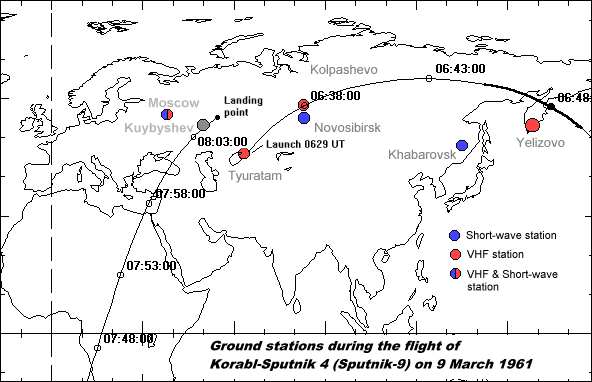

The spacecraft carrying the dog Chernuschka was launched from Baikonur at 0628:48 UT on 9 March 1961. The spacecraft weighed 4700 kg and entered an orbit at i = 64.93o and 183.5-248.8 km (2). This was the type of orbit intended to be used for manned flights in order to permit natural decay after ten days in case the retrorocket malfunctioned.
The only known report of signals from Sputnik-9 was publihsed many years after the end of the Cold war. In (8) the Radio Research Laboratories of the Japanese Ministry of Posts and Telecommunications in Tokyo reports having picked up signals on 19.995 MHz as the spacecraft had just passed their location about 20 minutes after launch.
The retro-rocket fired for 42.5 seconds. The ejection seat with the mannequin ejected. The dog stayed in the re-entry vehicle and both landed safely in an open field 260 km northeast of Kuybyshev (1). There was a delay in disarming the self-destruct system, so the dog had to be taken out of the capsule to avoid it freezing to death.
Kamanin wrote that receivers on the fourth floor of the KP building at Tyuratam picked up signals (0.5 sec carrier, 1.5 sec interval) from the P-37 beacon transmitter on 10.003 MHz at 0806-0810 UT. Since the P-37 antenna deploys when the parachute opens during descent, this showed that the craft was descending and had passed 4000 meters altitude. A direction finder at Volska-Engelsk (52.1 N, 47.4 E, not far from Kuybyshev (now called Samara), picked up the short-wave beacon. Nobody heard the VHF beacon (denoted P-57). At 0840 UT Kamanin got a call from Yuri Mozzhorin (at NII-4) in Moscow who reported that the "Krug" direction finders had determined the landing co-ordinates of the re-entry vehicle.
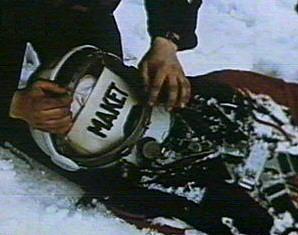 A
choir in orbit!
A
choir in orbit!".. The main purpose was to ensure reception of voice transmissions from ships Number 1 and 2 [Korabl-Sputniks 4 and 5]. We rejected a numerical countdown, fearing Western radio stations would monitor the human voice and raise a clamour throughout the world alleging that Russia has secretly put a man into orbit. A song also aroused objections because it would be said in the West that 'the Russian' cosmonaut had lost his head and started singing! It was then decided to tape a popular Piatnitsky Russian choir, and when the the dummy, clothed for the purposes of decency in a white smock, suddenly sang like a choir, it was very funny. "
"Do Not Touch- Report Immediately to the Local Organs Of Power". (5)To be on the safe side and not give people arriving on the scene that there was a dead person in the suit there was a placard inside the visor of the helmet with the word "Dummy" (MAKET in Russian). This precaution had been taken at the direct orders of chief designer Sergei Korolev (5). (See image above right. Published with the permission of Mark Wade, webmaster and publisher of Encyclopaedia Astronautica)
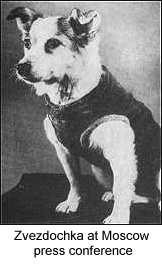 The
spacecraft carrying the dog Zvezdochka was launched from Baikonur at 0554 UT on
25 March 1961. The spacecraft weighed 4695 kg and entered an orbit at i =
64.9o and 178.1-247 km (2).
The
spacecraft carrying the dog Zvezdochka was launched from Baikonur at 0554 UT on
25 March 1961. The spacecraft weighed 4695 kg and entered an orbit at i =
64.9o and 178.1-247 km (2).
The Japanese Ministry of Posts and Telecommunications was obviously keeping a constant watch on 19.995 MHz in anticipation of Soviet space spectaculars. Therefore they picked up the telemetry signal on 19.995 MHz starting at 0608 UT, which was very soon after entry into orbit. They measured the Doppler shift and deternined that the closest approach to Tokyo occurred at 0612.12 UT (8). This time appears well compatible with the flight path plotted in tthe map below.
Cosmonaut chief Nikolai Kamanin wrote in his diary:
"... On board the ship which will start today there will be no cosmonaut, but there will be radio equipment such as that to be used during the manned flight. So today we have to practice conversations with a cosmonaut to convince ourselves of the reliability of the communications equipment. All that the ship and earth will transmit will be recorded. Before the launch I was at the KP and transmitted five times: 'Kedr ya Zarya, transmission check 1, 2, 3, 4, 5. How do you read, ya Zarya, over' ..." (3)The re-entry vehicle and ejection seat of Korabl-Sputnik-5 landed at approximately 0740 UT on 25 March 1961.(7)
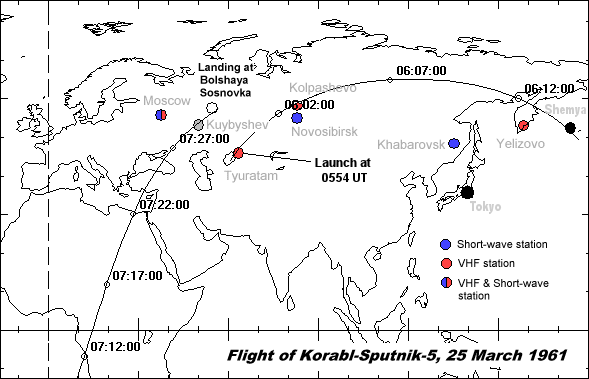
Only the next morning [26 March, even though the original text says 24 March] was it possible to send in a 4-seater plane, but at take-off it slid into a snow drift and a skid broke off. Another such plane finally made it to a place nearer to the landing site with three rescue workers. The plane landed on skis at the village Bolshaya Sosnova. The snow was 1.5 meters deep. The problem of how to reach the landing site was solved by the villagers providing a horse-drawn sleigh. In this way the rescue party finally reached the scorched and still hot capsule lying in a narrow gully with its parachute nearby. One of the three rescuers stayed with the capsule and the two others continued to the mannequin cosmonaut. They finally found the mechanical space traveller:
"... A short distance from the village outskirts, where fields began, was a streaming brook. Water from the early melting snow was gathering its strength, as if readying itself for an uncompromising fight with Siberian winter. On the other side of the brook there was a forest, cut by a short narrow opening. In the middle of that opening stood a big fir tree, with thick forest behind. The earth seemed to have been expecting this to happen, to have the chance to embrace the wonder created by man's intellect. Centenarians trees looked as if they had just parted to leave a small clearing, and in the middle, slightly reclining on one side, in deep snow, there was the orange-coloured hero.
One would think it was an exhausted traveller, frozen dead for having lost his fight with invincible Nature. But there were many puzzling things about this picture: the queer orange-coloured suit with a mysterious helmet on his head; the multitude of slings stretching out from his shoulders towards a large bright-coloured canopy, its apex sitting right under the crown of a great fir tree. The weather was cloudless and calm after the blizzard that had lasted so many days, and there was a special magic about the whole picture ..." (5).
Efimov then goes on to describe that the villagers were upset with the paratroopers for not being allowed to come to the rescue of the person in the space suit. The villagers did not believe the guarding paratroopers assertion that it was only a mannequin. The solution to this incident was that one of the village elders was allowed to walk up to Ivan Ivanovich to touch his rubbery face. After that the villagers were satisfied and went back to their normal routine.
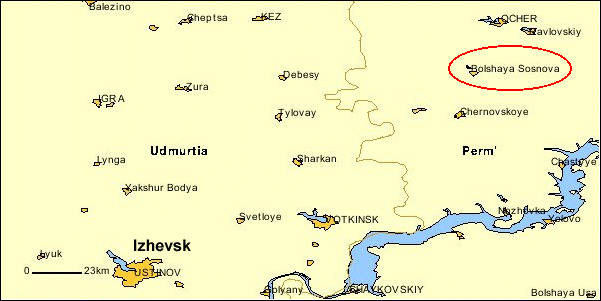
The re-entry vehicle of Korabl-Sputnik-5
was later used as a Vostok trainer at the cosmonaut training centre (6).